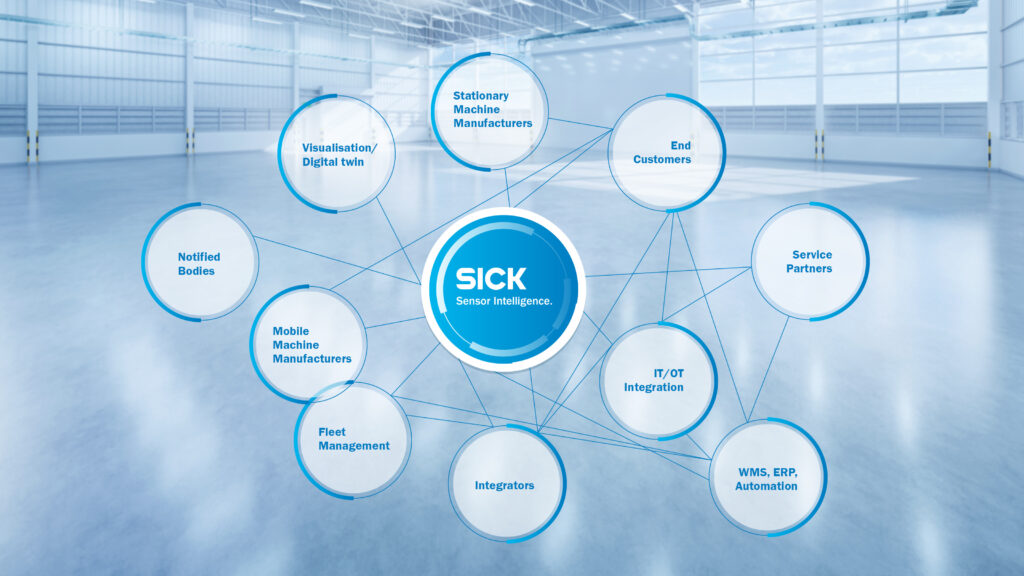An interview with SICK safety experts on how to improve productivity and safety in industrial automation
Our world is in a constant state of change. Digitalization is amplifying and accelerating this change in society and industry while also impacting on functional safety in the world of production. That’s why Dynamic Safety, the new holistic approach from SICK, is making the industry sit up and take notice.
Benjamin Heimpel, Head of Business Unit – Safety Systems & Services, and Patrick Vollmer, Head of Business Unit – Light Beam Systems, are convinced that Dynamic Safety can overcome previous limitations. It will make safety into a true game changer for cooperation and coexistence tasks, as the safety experts explain in this interview.
When you speak about Dynamic Safety, you keep using the term game changer. What do you mean by that?

Heimpel: Conventional safety concepts can no longer keep pace with the rapid technological developments. With automation opportunities being limited, a new approach is required to overcome this blockage. SICK, as a pioneer of safety solutions, intends to tackle applications that others may not to make them safe and automated.
Vollmer: This step will not just be a game changer from SICK’s perspective, but also from the viewpoint of the customer. Based on the discussions we have had with our customers, we know that they recognize what an enormous competitive advantage they will gain with Dynamic Safety.

Why are you doing this? What vision is behind it?
Heimpel: Because we are very close to our customers, we understand just how severely their productivity is being impacted by the shortage of skilled workers and the persistent global crisis scenarios. The pressure on companies to also automate areas in the past is continuously increasing, as this is the only way employees can be relieved of simple monotonous activities so they can focus on more interesting and demanding tasks. The big hurdle for the next step in automation has, to date, been the issue of safety in the collaboration of humans and automated platforms or robots. And we will overcome this hurdle with Dynamic Safety.
Vollmer: Companies would like to gain more resilience, or to be specific: they would like their production processes to run as fault free as possible, without interruptions. To achieve this aim, resilience management and Dynamic Safety pursue a holistic approach. All measures are aimed at maintaining the level of performance and even improving it regardless of any crises that may arise. Intelligent solutions for areas that could previously result in process disruptions foster resilience. SICK can create these solutions using Dynamic Safety because we are very familiar with our customer’s processes.

How might this work? How does Dynamic Safety differ from previous solutions?
Vollmer: We no longer just consider the individual machines and hazardous points of the customer, but instead determine, in real time, where persons or objects are located within the entire workflow. In other words, we deliver data on the positions of the actors, both humans and machines, and then allow processes to be situationally controlled within the dynamic environment. This enables us to increase the productivity while maintaining the quality and high throughput, and to safely automate the entire process end-to-end.
Heimpel: Being a full-service solutions provider, SICK not only wants to sell individual sensors, but also consider the applications holistically. We support our customers in all areas, from the actual safety concept right through to validation, training, and on-site project management. We act across all levels in the business ecosystem, which gives us the ability to overcome limitations and create added value for customers.

Does this mean the topic of business ecosystem is gaining importance at SICK?
Vollmer: Absolutely! Due to the changes resulting from digitalization and the diverse challenges they face, like for example the shortage of staff or the supply chain interruptions through external events, companies need to undergo organizational change. This affects the logistics and production environments where, with Dynamic Safety and in cooperation with our partners, we can achieve not only a competitive advantage for the entire network but also better, more sustainable added value.
Heimpel: We offer our customers the opportunity to approach us to jointly and systematically take on the challenges associated with automated applications. We are convinced that Dynamic Safety brings an enormous gain in resources and competencies for all participants in a business ecosystem. In the end, we can also expand in a business ecosystem the overall market in the relevant sector.
Where is SICK currently at in its development of Dynamic Safety?
Heimpel: At the moment, we are working on implementing our Dynamic Safety vision with pilot customers. We are trialing our prototype on a 24/7 line of a globally active company and are doing so under real production conditions. The solution is therefore being developed jointly with the customer. Dynamic Safety is, after all, based on a user-centered approach so we ensure the success of the developed solution through direct feedback from the application environment, management, right through to the employees on the line.
Vollmer: Dynamic Safety is a new approach for SICK, also internally. We want to move away from a more rigid way of thinking about safety, where sensors interrupt the process in case of danger, to a dynamic concept. One, for example, where speed reductions and routing changes no longer interrupt the production process. In future, employees will feel safe in their work environment without being consciously aware of the actual safety application. We have already received positive feedback on this from the pilot projects.
What is the future direction of SICK in the area of safety? Can you give us a brief overview of this?
Heimpel: Dynamic Safety is one of the core themes in our “Creating Safe Productivity” strategy. We realize that customers have, in the past, had to battle with challenges regarding productivity and safety. We believe, however, that the safety of machines and systems does not come at the expense of their productivity. On the contrary: With our new Dynamic Safety approach we aim to not only improve safety for the customer but also raise productivity to a totally new, systematic, and previously unseen level going forward. True to the motto of Creating Safe Productivity.
What excites you personally about the new safety concept?
Heimpel: I find it fascinating how the dynamic aspect of this concept, as indicated in the name, also broadens our own horizons, deepens our understanding of our customers needs, and thereby accelerates the development of new solutions.
Vollmer: With Dynamic Safety, we are shaping the future of SICK. That is very inspiring and motivating for me.





